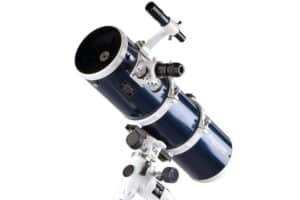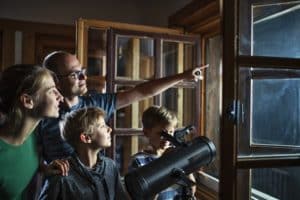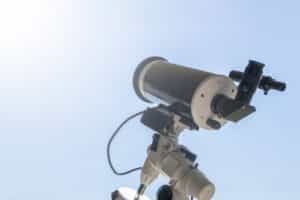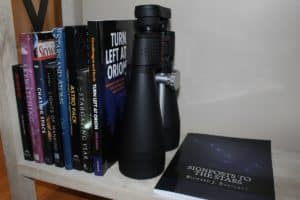Looking for the best telescope under $500? In this price range, you’ll find telescopes with large enough apertures and enough power to view the moon and planets in spectacular detail, or even see distant galaxies, star clusters, and nebulae. In this post, we’ll share our top 7 recommendations for the best telescope under $500. We’re confident you’ll find something here that meets your needs.
See also:
(Before we begin, please note that product pricing, price categories and availability are accurate as of the date of this post, but are subject to change. This post represents the author’s opinion, based on research and experience, of the “best” or “top” telescopes in this category; the opinions of others may vary.)
Best Telescope Under $500 (Our Top 7 Picks)
Note: After you’ve gone through this page, we recommend you also check out our Best Telescopes Under $1000. You might be able to catch a good sale price and still end up within your $500 budget.
Orion 09007 SpaceProbe 130ST Telescope Equatorial Reflector
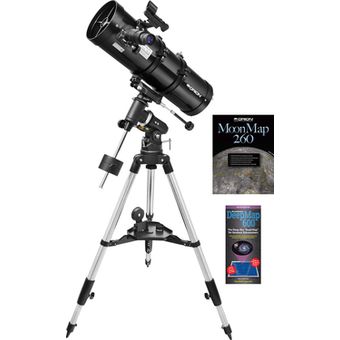
Image Credit: Orion (Used with Permission)
If you’re looking for an equatorial mount and great quality optics – this Orion reflector is one of our top picks for the best telescope under $500. This is an equatorial reflector telescope that has a great ratio of price vs. performance. Plus, it’s more compact and transportable than a typical reflector of similar size aperture, making it a great choice for balancing power with portability. As a result, it’s a fantastic choice for an amateur looking for a good blend of performance, quality, portability, and the smooth tracking that’s possible with an equatorial mount.
Scorecard – Orion 09007 SpaceProbe 130ST Telescope Equatorial Reflector
| Category | Our Verdict | Why? |
|---|---|---|
| Skill Level | Beginner to Intermediate | Suitable for beginners but can grow with you |
| Quality | 4 out of 5 | Great component quality |
| Ease of Use | 3 out of 5 | Requires collimation plus EQ controls require skill |
| Power & Clarity | 4 out of 5 | Wide aperture for bright images |
| Control | 5 out of 5 | Smooth EQ controls for manual tracking with sturdy EQ-2 mount |
| Portability | 4 out of 5 | Compact 'short tube' design for portability |
| Accessories | 4 out of 5 | Everything needed plus two eyepieces |
| Overall Value | 4 out of 5 | Great value |
Why We Like It
Most importantly, the 130ST delivers excellent optical performance with a wide 130mm (5.1 inches) primary mirror. It collects plenty of light for beautiful, clear & bright images. Its short focal length of 650mm gives it a relatively compact 24 inch optical tube (thus the “ST” or “short tube” designation).
This special combination of power and compactness makes the 130ST a versatile and “fast” telescope (f/5 focal ratio) – ideal for deep-sky viewing and a wide field of view. The optical design of this telescope provides for high-quality, sharp images and a great viewing experience. It features a true parabolic primary mirror, and a secondary mirror held in an advanced holder (with thin metal vanes to reduce diffraction spikes and light loss).
Next, we love the sturdy EQ-2 mount as it provides smooth equatorial slow-motion controls, so you can track celestial objects with fine adjustments as they move across the sky due to the rotation of the earth. The EQ-2 is counterweighted and heavy enough to provide stable usability and control.
In terms of portability, the “short tube” design makes the 130ST far more portable than other Newtonian reflectors of similar aperture size. It weighs just 27 lbs. fully assembled and can be easily transported to your favorite viewing location.
Finally, it comes with everything you need, including two 1.25″ Sirius Plossl eyepieces (25mm and 10mm, for magnification of 26x and 65x respectively), plus a 6×30 finder scope, tripod accessory tray, a cap for collimation, 1.25″ rack and pinion focuser, Orion’s Starry Night astronomy software, and more.
So, if you’re looking for a fantastic blend of quality, portability, power, and fine EQ control – the 130ST is a great choice!
Pros
- Powerful optics
- Versatility and compactness with “short tube” design
- Sturdy EQ-2 mount w/ slow-motion controls and double setting circles
- Good starter accessories
- Portability above-average compared to similar size aperture telescopes
Cons
- You’ll need to learn to collimate it, plus learn to use the EQ controls
Recommended Accessories
Click here to expand- You can add a motor drive to the EQ-2 mount:
- Smartphone mount:
Orion 10016 StarBlast 6 Astro Reflector Telescope
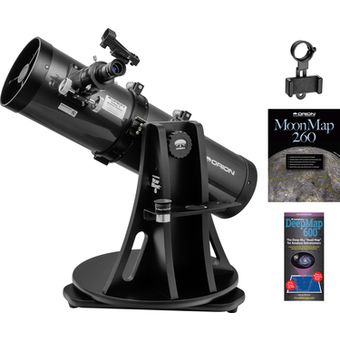
Image Credit: Orion (Used with Permission)
Wonderful 6″ table-top reflector – if you’re looking for something compact and user-friendly, (and fun!) without sacrificing power. Orion does a really nice job with its table-top offerings. We love this 6″ reflector telescope because it combines the power of a large 6″ primary mirror with the ease-of-use and portability of the table-top design. If you’re shopping on a budget under $500, this is a fantastic choice for entry-level and seasonal astronomers. We highly recommend this telescope if you’re looking for a flexible, versatile telescope but you also care about quality and optical performance.
Scorecard – Orion 10016 StarBlast 6 Astro Reflector Telescope
| Category | Our Verdict | Why? |
|---|---|---|
| Skill Level | Beginner | Suitable for beginners |
| Quality | 4 out of 5 | Great component quality |
| Ease of Use | 4 out of 5 | Easy to use tabletop design; requires collimation |
| Power & Clarity | 4 out of 5 | Bright images with 6" primary mirror |
| Control | 4 out of 5 | Easy to point and move; requires manual tracking of objects with AZ mount |
| Portability | 4 out of 5 | Super compact and easy to setup for a 6" telescope, weighs just 23.5 lbs. |
| Accessories | 4 out of 5 | Everything needed to get started, includes 2 eyepieces |
| Overall Value | 4 out of 5 | Great value |
Why We Like It
The #1 reason to buy this telescope is for its exceptional compactness, versatility, and user-friendly design. It’s simple to carry with you wherever you go because you don’t need a bulky tripod. The height makes this telescope easy for kids to use, making it a fun telescope for the family.
It’s quite similar to the Orion StarBlast 4.5, but the 6″ aperture is a huge upgrade and provides a lot more light-gathering capability for brighter and clearer images within the solar system, plus at 6″ you’ll be able to see some of the fainter objects, galaxy, star clusters, and nebulae. It has a short focal length of 750mm which helps make the telescope more compact and provides a wider field of view compared with longer 6″ reflectors.
We love the “table top” design which makes the telescope super easy to setup and use (while still requiring collimation from time to time). You can easily bring it with you camping, hiking, sailing, or set it up in your backyard for flexible viewing experiences. The little tabletop base is pre-assembled, so you’re all set to start using the unit right after unboxing it.
Includes a good set of initial accessories, including two Sirius Plossl 1.25″ eyepieces (25mm and 10mm, for 30x ad 75x magnification respectively), EZ Finder II aiming device, eyepiece rack, Starry Night software, and more. Overall this is a great choice for a family telescope or something with maximum versatility for a variety of viewing scenarios.
Pros
- Super compact and portable “table top” design
- User-friendly and versatile
- Large 6″ aperture is a huge upgrade from the StarBlast 4.5
- Eyepiece rack
- Short focal distance for wide field of view
Cons
- As with all reflectors, you’ll need to learn how to collimate this telescope
- While we like the AZ mount on this telescope because of its compact, easy-to-use tabletop design, you’ll still need to track objects manually
Celestron 114LCM Computerized Newtonian Telescope
If you’re looking for an affordable “go to” (fully computerized) telescope, this is an entry-level option to consider. This is optically the largest telescope in the LCM series from Celestron. These telescopes are targeted at budget-conscious users who are nevertheless looking for high-end computerized capability. The 114LCM includes the same NexStar+ handheld computer that’s included in Celestron’s more advanced telescopes. The optical quality is so-so but that’s the tradeoff here. You get an OK telescope with a killer computer system for sophisticated automation of the viewing experience.
Scorecard – Celestron 114LCM Computerized Newtonian Telescope
| Category | Our Verdict | Why? |
|---|---|---|
| Skill Level | Beginner | For beginners but make sure you learn how to collimate |
| Quality | 3 out of 5 | Entry-level telescope |
| Ease of Use | 3 out of 5 | Collimation is difficult for Bird-Jones scope |
| Power & Clarity | 3 out of 5 | Optics are decent but not great for this price range |
| Control | 5 out of 5 | Fully computerized telescope |
| Portability | 4 out of 5 | Light-weight and easy to move |
| Accessories | 3 out of 5 | Everything you need to get started |
| Overall Value | 3 out of 5 | Good value if your priority is computer control |
Why We Like It
What’s awesome about the 114LCM is that it includes the same high-tech features that are part of much more expensive Celestron telescopes. With the NexStar+ handheld computer integrated with its lightweight Alt-Az mount, you’ll have easy access to thousands of celestial objects. It uses the same SkyAlign procedure to give you precise control, and includes features like the Sky Tour. (The Sky Tour will give you a list of the best viewing targets given the time and location.)
However, if you’re looking for a fully computerized telescope in this price category, you need to be prepared to make a few compromises. The aperture (114mm) is a bit smaller than non-computerized telescopes in this price range. Additionally, the biggest drawback on this scope is that it’s a Bird-Jones style reflector. And this particular design can be tricky to collimate if you don’t put in the time to learn how to do it properly.
It comes with two 1.25” eyepieces (25mm and 9mm, giving you magnification of 60x and 167x), a StarPointer red dot finderscope, and Celestron’s Starry Night astronomy software.
Pros
- Full computerized “go to” capability with a database of thousands of celestial objects
- Includes two eyepieces and everything you need to get started
- Lightweight at only 13.2 lbs.
- 2 year warranty from Celestron
Cons
- Watch out for the Bird-Jones style reflector – while this allows for a compact and affordable design, these are tricky to collimate and you’ll need to invest the time to learn to do it properly. This is the biggest tradeoff in order to get such an affordable computerized reflector.
Celestron StarSense Explorer DX 130AZ Smartphone App-Enabled Telescope
For smartphone-based, visual navigation of the night-time sky. The StarSense Explorer DX telescope from Celestron features what is basically a smartphone-powered, super-charged view-finder. Instead of manually finding your target in the sky, the telescope uses your smartphone’s camera as the view finder. It’s able to precisely determine the direction of the telescope by analyzing the star patterns it sees. You can select your target from a list, and then the smartphone guides you to your target visually!
Scorecard – Celestron StarSense Explorer DX 130AZ
| Category | Our Verdict | Why? |
|---|---|---|
| Skill Level | Beginner | Smartphone navigation, easy for beginners |
| Quality | 4 out of 5 | Great warranty and solid component quality |
| Ease of Use | 5 out of 5 | The smartphone technology makes this ultra easy to use |
| Power & Clarity | 4 out of 5 | 5" aperture |
| Control | 4 out of 5 | Dual axis slow motion control (alt-az) |
| Portability | 4 out of 5 | Pretty good for a 5" telescope, 18 lbs. weight |
| Accessories | 3 out of 5 | Everything needed to get started, plus two eyepieces |
| Overall Value | 4 out of 5 | Great technology experience |
Why We Like It
One of the classic downsides of a full “go to” or computerized telescope is that it robs the user of the wondrous experience of exploring and navigating the sky visually. However, with a classic view finder, it’s a two-step process to find objects in the sky. (First you have to find it visually using a star map, then you have to use your telescope view-finder to “star hop” to the desired location.)
What’s really cool about the StarSense DX is that it gives you a great compromise between these two extremes. You’ll learn to navigate and find your way around the sky, but it’s also much easier and faster than the traditional two-step process.
In addition to the patent-pending smartphone technology experience, it’s also a pretty capable telescope for visual astronomy. It’s a high-quality 5″ Newtonian reflector that will let in enough light to see some beautiful images of objects in the solar system, and also some of the fainter and more distant sights in the sky. It comes with all the basic accessories you need, including two eyepieces (25mm and 10mm, for 26x and 65x magnification respectively), a red dot finderscope (in case you want to manually use a view-finder instead of using your phone), a tripod, and more.
Pros
- Patent-pending smartphone-based navigation technology
- Great quality optics with 5″ primary mirror
- Dual-axis slow motion controls
- Includes two eyepieces and everything you need to get started
- 2 year warranty from Celestron
Cons
- Lower magnification out of the box but you can add additional eyepieces for higher magnification
Orion 9024 AstroView 90mm Equatorial Refractor Telescope
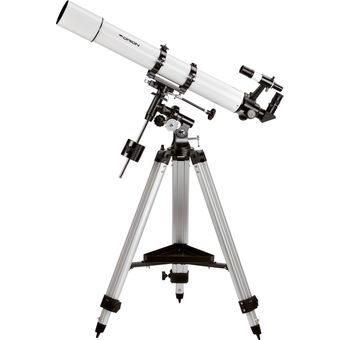
Image Credit: Orion (Used with Permission)
You’ll love this large-aperture refractor telescope with a sturdy equatorial mount. If you’re on a budget and you’re looking to prioritize power combined with sturdiness and overall quality – the Orion AstroView 90mm equatorial refractor telescope might be what you’re looking for. With its 90mm lens and manual equatorial controls, this telescope is higher quality than you might expect at first glance. Its main tube, hefty mount, solid tripod, and high-contrast optics offer a fantastic value.
Scorecard – Orion 9024 AstroView 90mm Equatorial Refractor Telescope
| Category | Our Verdict | Why? |
|---|---|---|
| Skill Level | Beginner to Intermediate | Good for beginners; can grow with you |
| Quality | 4 out of 5 | Great component quality |
| Ease of Use | 4 out of 5 | Easy to setup with detailed instructions |
| Power & Clarity | 4 out of 5 | Great optics and wide aperture |
| Control | 5 out of 5 | Sturdy EQ-2 equatorial mount with slow-motion controls |
| Portability | 3 out of 5 | A bit on the heavy side |
| Accessories | 4 out of 5 | Above average selection of included accessories |
| Overall Value | 4 out of 5 | Great value |
Why We Like It
This 90mm refractor from Orion offers an excellent value, and it’s a huge step up from many of the budget telescopes you’ll see in 80mm range and below.
First, this is not a starter telescope by any means – it weighs 25 lbs. and it’s almost 5′ tall when fully assembled. The 90mm aperture allows for stunning, high-contrast, detailed views of the moon, and it offers superb planetary viewing. Due to its large aperture, it can also be used for deep-sky viewing in the right conditions.
Second, it features a manual German equatorial mount and tripod which is heavier than the typical starter telescope. The equatorial mount includes slow-motion control and is ideal for tracking objects. This equatorial mount can also be upgraded with the EQ-2M electronic motorized drive for automatic tracking.
You’ll love the included accessories – including two Sirius Plossl eyepieces (25mm, 10mm), smooth-adjusting focuser, a finder scope (6×30), a 90-degree diagonal (to help make astronomical viewing more comfortable), Orion’s “Starry Night” software, and more. The telescope is also suitable for daytime scenic and wildlife viewing with separate purchase of a correct-image diagonal. Despite the great accessories package, you may want to invest in additional accessories: e.g. additional eyepieces, Orion’s motorized EQ-2M drive, a 2x Barlow lens, filters, and/or a travel case.
Pros
- All-around high quality telescope
- Heavy & sturdy equatorial mount and tripod
- Great clarity for viewing detailed images
Cons
- Not ideal for traveling
- With tripod legs fully extended, the mount can be a little wobbly
Recommended Accessories
Click here to expand- You can add a motor drive to the EQ-2 mount:
- 1.25″ eyepiece upgrades, including a 2x Barlow lens:
Gskyer 600x90mm AZ Astronomical Refractor Telescope
Cost-effective Alt-Az refractor for beginners. This Gskyer 90mm telescope offers great overall value with a wide 90mm aperture and an easy-to-use Alt-Azimuth mount. It offers an attractive blend of features with a wide variety of accessories for getting started.
Scorecard – Gskyer 600x90mm AZ Astronomical Refractor Telescope
| Category | Our Verdict | Why? |
|---|---|---|
| Skill Level | Beginner | Suitable for beginners |
| Quality | 3 out of 5 | Heavy main tube; entry-level components |
| Ease of Use | 4 out of 5 | Easy to setup and use |
| Power & Clarity | 3 out of 5 | Average optical performance |
| Control | 3 out of 5 | Average, AZ mount |
| Portability | 4 out of 5 | Easy to bring with you into the field |
| Accessories | 4 out of 5 | Wide selection of accessories included |
| Overall Value | 4 out of 5 | Great value |
Why We Like It
From an optics perspective, we like the wide 90mm lens (glass with high-transmission coatings). With a short focal distance of 600mm, it offers a wide field of view for getting started with astronomy. Magnification is decent with 24x, 60x, 120x options (with the three included eyepieces).
We love the wide selection of entry-level accessories that comes with this telescope. It comes with three eyepieces (25mm, 10mm, 5mm) and one 3x Barlow lens. (Of course, keep in mind the limitations of using a Barlow lens with a 90mm telescope.) It also comes with a positive-image finder scope, and a 48° erecting prism for easy and intuitive viewing. (For beginners, it’s nice to have images right side up.) You’ll also find a smartphone mount, a remote control for taking pictures, and an adjustable stainless steel tripod. It doesn’t require tools, and it’s quick and easy to focus.
The quality is decent, with a heavy metal main tube and solid stainless steel tripod – but don’t expect this to be a high-end telescope. The Alt-Az mount is easy to use for beginners but does not offer fine slow-motion controls. Both axes are tightened with the same handle.
Pros
- Large 90mm aperture, good value for the cost
- Easy to use and setup
- Includes everything you need to get started
- Smartphone mount and remote control included
- Sturdy stainless steel tripod
Cons
- Only 1 year limited warranty
- Don’t expect too much from the 3x Barlow accessory – it’s plastic (plus, this telescope is not for super high magnification)
- Single handle for tightening the alt-az mount along both axes
Honorable Mention – If Your Budget is More Flexible
Orion 8944 SkyQuest XT6 Classic Dobsonian Telescope
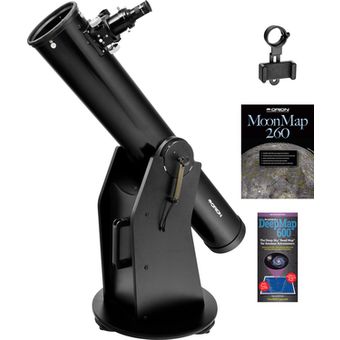
Image Credit: Orion (Used with Permission)
Dobsonian telescope featuring a huge 150mm reflector, with excellent affordability and ease-of-use. If you’re getting started in astronomy and you’re looking for a telescope that will give you many years of viewing pleasure, you should definitely check out this Dobsonian from Orion. The great thing about Dobsonian telescopes is that they are designed using low-cost components, and they are super easy to use – so, you’ll get a lot more aperture for your money, and you’ll find the mount easy and intuitive to use. Also, it will fit nicely in your vehicle, so you can take it with you to a dark sky location to get wonderful glimpses of Jupiter’s red spot, Saturn’s rings, Jupiter’s moons, and even deep-sky objects, galaxies, and nebulae.
A Dobsonian telescope is a fantastic choice for a first telescope, because it’s designed to make viewing easy, powerful, and affordable. Its unique low-cost design makes amateur astronomy far more accessible to the general market. You’ll spend more of your time enjoying the sights and learning how to navigate the sky – instead of fiddling with the telescope.
Scorecard – Orion 8944 SkyQuest XT6 Classic Dobsonian Telescope
| Category | Our Verdict | Why? |
|---|---|---|
| Skill Level | Beginner | Suitable for beginners |
| Quality | 4 out of 5 | Great component quality |
| Ease of Use | 4 out of 5 | Requires collimation but overall ease of use is high |
| Power & Clarity | 4 out of 5 | Wide aperture for bright images |
| Control | 4 out of 5 | Easy to use, requires manual tracking |
| Portability | 3 out of 5 | A little heavy, but still portable |
| Accessories | 3 out of 5 | Just the essentials and one eyepiece |
| Overall Value | 4 out of 5 | Great value |
Why We Like It
The Orion SkyQuest XT6 is a classic Newtonian reflector telescope featuring a huge 6″ (150mm) primary parabolic mirror with a long focal length (1200mm) – making it the perfect choice for detailed planetary views with a f/8 focal ratio. (Remember, the amount of light collection is related to the square of the diameter, so a 6″ telescope collects nearly 80% more light than a 4.5″ aperture.) While magnification out of the box is only 48x (with the included 25mm Sirius Plossl eyepiece), it’s capable of a high theoretical magnification of 300x with separately purchased eyepieces. With this optical setup, you’ll also notice more detail when viewing deep-sky objects, nebulae, distant galaxies, and star clusters.
The mount is a special Dobsonian variation of the Alt-Azimuth. It sits on a sturdy base (not a tripod), and the optical tube glides smoothly on the cabinet-quality Dobsonian wood base. With its non-stick PTFE/Nylon altitude and azimuth pads, and “CorrecTension” springs, you can simply point the telescope by hand where you want to look. The springs keep the tube balanced and provide for smooth, precise movement.
Finally, the XT6 is a “grab and go” telescope – you can take it with you to a dark-sky location (but it’s still somewhat heavy at 34.4 lbs., so it’s not a traveling telescope). It’s simple to assemble and sturdy enough to last years.
One downside of the XT6 is the accessories are fairly basic: It comes with one 25mm Sirius Plossl eyepiece (so you’ll almost certainly need to purchase additional eyepieces to get maximum usage from the telescope). It also includes a EZ Finder II finder scope, 1.25″ rack-and-pinion focuser, and Orion’s Starry Night Special Edition software.
Pros
- Large 150mm (6″) aperture
- Sturdy, affordable Dobsonian construction
- Long focal length is ideal for zooming in on planetary details
- Easy to carry and setup
Cons
- Only 1 year limited warranty
- A little heavy at 34.4 lbs. fully assembled, but you can still fit it easily in a vehicle
- You’ll need to learn how to collimate it
Recommended Accessories
Click here to expand- Adding more eyepieces will enhance the versatility of your viewing options with the XT6. Here’s a kit from Orion that includes a variety of 1.25″ eyepiece upgrades, including a 6.3mm (for high magnification) plus a moon filter and more:
- If your budget is just a little higher, you might want to check out the “XT6 Plus” which includes a few additional upgrades compared to the XT6: See it on Telescope.com or See it on Amazon.com
Buying Guide for Best Telescope Under $500
Choosing a telescope can be confusing. There are many different designs, features, and options to consider. If you’re shopping for the best telescope on a budget under $500, here are our general thoughts on the options available to you.
Basic Options – Consider a Dobsonian or a Simple Alt-Az
- For the average backyard or dark-sky location amateur, we would suggest that you strongly consider buying a 8″ Dobsonian telescope (see our #1 and #3 picks in the article above). This is (in our opinion) the most cost-effective way to get a large aperture (for amazing viewing) combined with an affordable, practical, transportable, and user-friendly experience. It’s a fantastic design if you want to spend your viewing sessions taking in the beauty of the sky, and learning how to navigate by star-hopping and looking at a variety of sights in each session.
- If you want something that is “drop dead easy to use”, then go with an Alt-Az refractor (see our #7 pick above). Refractors require almost zero maintenance, and with an Alt-Az mount you’ll be able to point it anywhere with ease.
- Consider a table-top telescope if you want the ultimate in flexibility and versatility. We love the Orion StarBlast line, and you can get a 6″ reflector tabletop on a budget under $500. (See our #4 pick above.)
More Advanced Options – Equatorial or Technology-Assisted
- If you want the “smooth tracking” of an equatorial mount telescope (so you can spend a lot more time looking at a single object before it drifts out of your view), we would recommend you buy a 6″ reflector (see our #2 pick above). Equatorial mounts take a little more experience and time to setup, and for the average beginner you may find it frustrating – however, the benefits are precision control and smooth tracking of objects. If you like to spend a long time viewing each object, you’ll definitely find this investment to be worthwhile.
- If you are looking for a computerized or smartphone-assisted viewing experience (so you can find almost anything in the sky with ease and speed), then we would recommend a computerized reflector, or a smartphone-assisted telescope. (See our #5 and #6 picks above.)
Refracting vs. Reflecting Telescopes
Each of the major types of telescope has advantages and disadvantages. Very broadly, below is a quick comparison.
- Cost – You’ll typically find a good-quality refractor costs more (for similar aperture size) than a reflector. Mirrors are cheaper to manufacture. (And the cost can increase even further for higher quality refracting lenses – e.g. a doublet or triplet “apochromatic” lens costs a lot more than a more typical “achromatic” lens.) So, if you are looking to maximize value, you might prefer a reflecting telescope.
- Size – All things being equal, reflectors are smaller than refractors due to the folding of light using the mirror system employed by reflecting telescopes.
- Maintenance – Reflectors require a process called “collimation” because the mirrors need to be aligned for proper performance. A poorly collimated reflector will appear blurry and will be difficult to focus. Refractors tend to have fixed lenses, so they don’t usually need adjustment.
- Optical performance – In general terms, a high-quality refractor produces the sharpest and clearest images. (For example, imaging enthusiasts love to use APO refractors for astrophotography.) However, a lower quality refracting lens introduces the possibility of chromatic aberration (where different colors focus differently, causing distortion and blurring). Reflectors are not subject to this chromatic aberration – so, if you’re on a budget, reflectors are often the better choice for optical clarity if you’re looking to maximize the size of aperture.
- Ease of use – You can’t beat the simplicity of a refracting telescope. If you’re looking for a telescope that sets up in minutes, you’ll want to get a refractor. However, unless you have a large budget, you’ll get better viewing of the cosmos with a large-aperture reflector.
For more discussion of these (and other) differences, see our full comparison of refracting vs. reflecting telescopes.
Aperture – Bigger is Better
Most people believe that a telescope’s main job is magnification. However, that’s not true! A telescope’s primary role is to gather light. And, the size of the aperture – i.e. the primary light-gathering opening (the objective lens on a refractor, or the primary mirror on a reflector) – determines how much light can be gathered at a particular time.
When choosing a telescope, you should aim to get the largest aperture available within your budget (as long as the telescope type fits your needs in terms of portability, etc.). In general, the larger the aperture, the more powerful the telescope. A larger aperture allows for brighter images.
Also, a larger aperture can make it possible to achieve higher magnification. Have you ever tried to zoom in on a low-resolution image? It appears grainy and blurry. It’s the same with a telescope – you can typically magnify images more with a larger aperture. Since you’re collecting more light, you can zoom in a little more with your eyepiece without sacrificing as much image quality.
Choosing a Mount
There are basically two types of mounting systems for telescopes. Here’s a very basic summary:
1. Alt-Azimuth Mounts
The first type of mount is the Alt-Az or Alt-Azimuth. It moves along two axes w/ vertical and horizontal motions. (If you want to get technical, the two axes of rotation are the horizontal direction, i.e. the “Azimuth” or compass bearing, and the vertical direction, i.e. the “Altitude” or “Alt” for short.) This is the simplest and easiest-to-use mount for beginner telescopes because it works the way you would expect, similar to a camera tripod. To use it, you simply point it where you want to look and tighten it down. Some models come with knobs for slow motion so you can make finer adjustments.
2. Equatorial Mounts
The other major type of telescope mount is the “equatorial” which is a special type of mount designed specifically for tracking astronomical objects as the earth rotates. (When you use any telescope mount, your target will continuously drift away from the center of your eyepiece; an equatorial mount is designed to make it easy for you to keep it in the center.) An equatorial mount is harder for beginners to use because it takes some time to learn how to properly align, and it’s less intuitive initially to find objects with it. However, once it is properly aligned, you can track objects in the sky using slow-motion control along a single axis (whereas the Alt-Az requires continuous movement of both axes). An equatorial mount has two axes of movement – (a) along the equatorial axis (this is called right ascension), and (b) along the perpendicular axis (known as declination).
Computerized Mounts
Both Alt-Az and Equatorial mounts can be motorized or even computerized, allowing a computer system to automatically control the direction and tracking of the telescope. Some of the computerized mounts (known as “Go To” mounts) include large databases of astronomical objects, automating the task of finding things in the sky.
Dobsonian Telescopes
Finally – there is one special type of Alt-Az mount deserving a special mention – and that is the Dobsonian telescope design. This particular telescope design is widely recommended as the best option for the average amateur astronomer, because it provides a special blend of affordability with ease-of-use and power using a unique design variation of the Alt-Az mount combined with a large Newtonian reflector telescope. Check out our entire guide to Dobsonian telescopes here.
Eyepieces
An ocular lens or eyepiece is the part of a telescope that you look through while using it.
The focal length of the eyepiece is what determines you magnification level. (To calculate this, you simply divide the focal distance of your telescope by the focal length of the eyepiece. For example, a 1000mm telescope with a 10mm eyepiece will yield a magnification of 100x.) The eyepiece locates before the focal point and helps you to magnify the view coming through.
There are many different types and sizes of eyepieces. When you’re getting started with a first telescope, it’s good to have a few different eyepiece combinations (plus a Barlow lens which can provide higher magnification when coupled with any eyepiece). This will give you more flexibility to try viewing different objects at various levels of magnification.
Frequently Asked Questions (FAQ) for Best Telescope Under $500
Should I Use A Computerized Telescope?
This is definitely a matter of personal preference. Many beginners are attracted to computerized “go to” telescopes because they offer the ability to quickly and easily navigate to thousands of targets in the night sky with the press of a button. Once you get familiar with the user interface, a computerized telescope will make your viewing sessions “jam packed” as you hop around the sky with ease and spend your time looking at the various sights.
However, there are several drawbacks worth considering. First, computerized telescopes take a little longer for setup as you’ll typically need to calibrate the navigation system by manually locating several bright objects. This gets easier with practice, but it can be a hurdle for getting started quickly. (The fancier ones can do this automatically, but this increases cost.) Second, if you really want to learn astronomy, the computerized features can act as a “crutch” and ultimately may slow down the practical knowledge you’ll gain from learning how to manually star-hop to your destination. Third, computerized features come at an additional cost, so budget astronomers will do better by prioritizing aperture over computer-assisted capabilities.
What Are The Advantages Of A Dobsonian Telescope?
Dobsonian telescopes are a great choice for getting started with astronomy and making your budget stretch as far as possible. (Indeed, 2 of our top 3 recommendations for best telescope under $500 are Dobsonian designs.) Here are the top 3 reasons to choose a Dobsonian for a first telescope:
- Affordability. Dobsonian telescopes offer the best possible aperture vs. cost ratio compared to any other type of telescope. It uses mirrors instead of more expensive lenses, and the mount is made using low-cost components. If your #1 priority is to see the brightest and most detailed images possible within your budget, then this is the telescope to beat.
- Easy to point and view, “grab and go” telescope. With its unique, floor-based, friction-balanced Alt-Az mount design, you don’t need to fiddle with knobs and controls to point the telescope in the direction of whatever you want to look at. You simply point the telescope where you want to look, check the finder scope, and then look through the eyepiece. For this reason, Dobsonian telescopes are a lot of fun and super easy to use.
- Learning the skies. If you love astronomy and you want to get a lot of experience navigating the sky manually, this is a great option. You can quickly and easily set it up in your backyard or take it with you to a dark-sky location, and you’ll learn how to “star hop” and find various targets in the sky.
What Can I View Through My Telescope?
There are thousands of objects you can view through your telescope. With the telescopes on this page, you’ll have enough power to get wonderful views of the moon (including detailed views of craters on the moon) and the planets in our solar system (including details like the rings of Saturn, the moons and bands of Jupiter, and even Saturn’s Cassini Division with the 8″ reflectors on this page).
With some of the larger apertures on this page you can also see deeper, fainters objects in the sky including distant galaxies and nebulae. Be sure to check out our top 6 things to see with a telescope. And, here’s a great article from Sky & Telescope magazine highlighting some more things you can see with your new telescope: https://skyandtelescope.org/observing/what-to-see-with-your-new-telescope/
Conclusion – Best Telescope Under $500
With a healthy budget of $500, you’re starting to get in range of some excellent telescopes that will give you years of wonderful viewing experiences. If you’re looking to maximize power, our #1 pick is a solid choice as it gives you a huge aperture in a practical, versatile, affordable overall design. Be sure to check out the other options as well, for a variety of other needs and priorities. Ultimately, we’re confident you’ll find something in this price range that will be a great fit – so, now it’s up to you to pick one and get started!
(Also, if you liked this article, please share it using the social media buttons below!)
Feature Image Credit: Lucas Pezeta / Pexels







